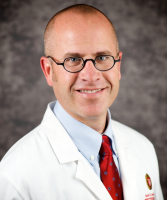Searching for new antibiotics under the sea and among battling bacteria


A multi-disciplinary strategy for finding new antimicrobial candidates is taking cues from environmental biology and ecology.
Genomic studies have shown that many bacterial species have a treasure trove of genes involved in synthesizing novel antibiotics, but they aren't expressed under standard laboratory culture conditions - so researchers are challenging bacteria by making them compete with one another.
The co-culturing research is funded by a Center of Excellence for Translational Research grant to David Andes, MD (pictured at upper right), professor and head, Infectious Disease.
One compound called keyicin was discovered by this strategy through work by the research teams of Tim Bugni, PhD, associate professor, School of Pharmacy and Cameron Currie, PhD, professor, Department of Bacteriology.
Resources:
- "Searching the sea, and bacterial battles, for new antibiotics," UW-Madison, June 6, 2018
Photo (top): Symbiotic fungus grows on the exoskeleton a leaf-cutter ant, which is surrounded by both harmful and helpful bacteria. The ant colonies are bathed in a soup of natural antibiotics, which researchers purify and test to see whether they could be used clinically. Image courtesy of the Cameron Currie laboratory.